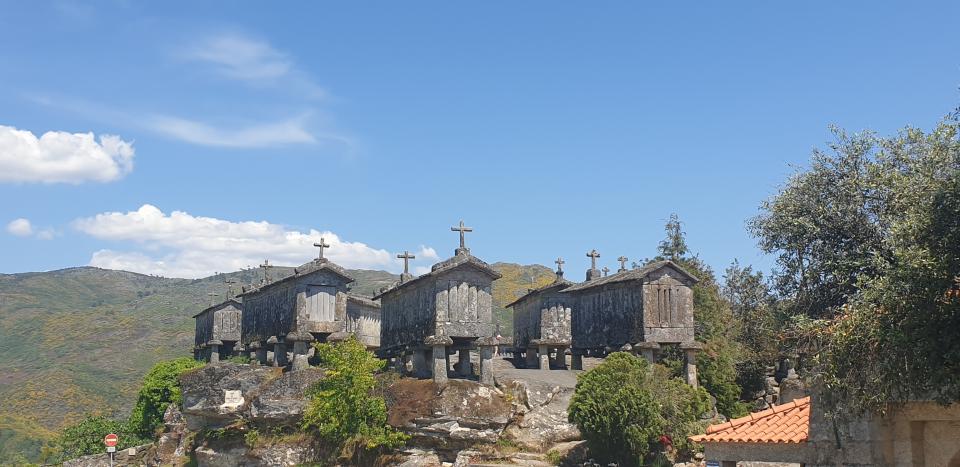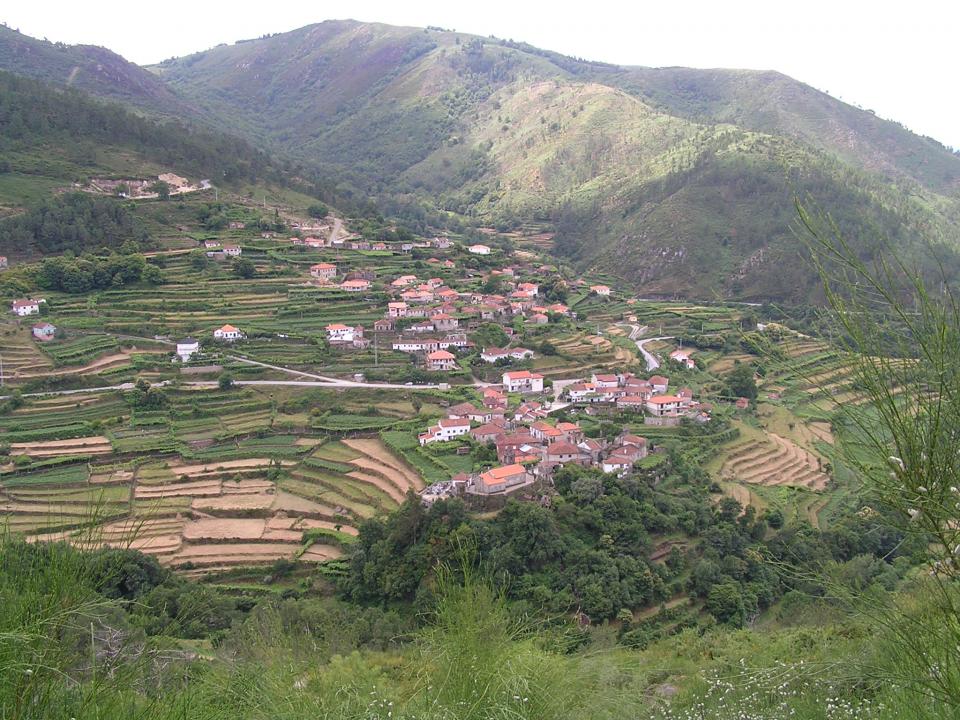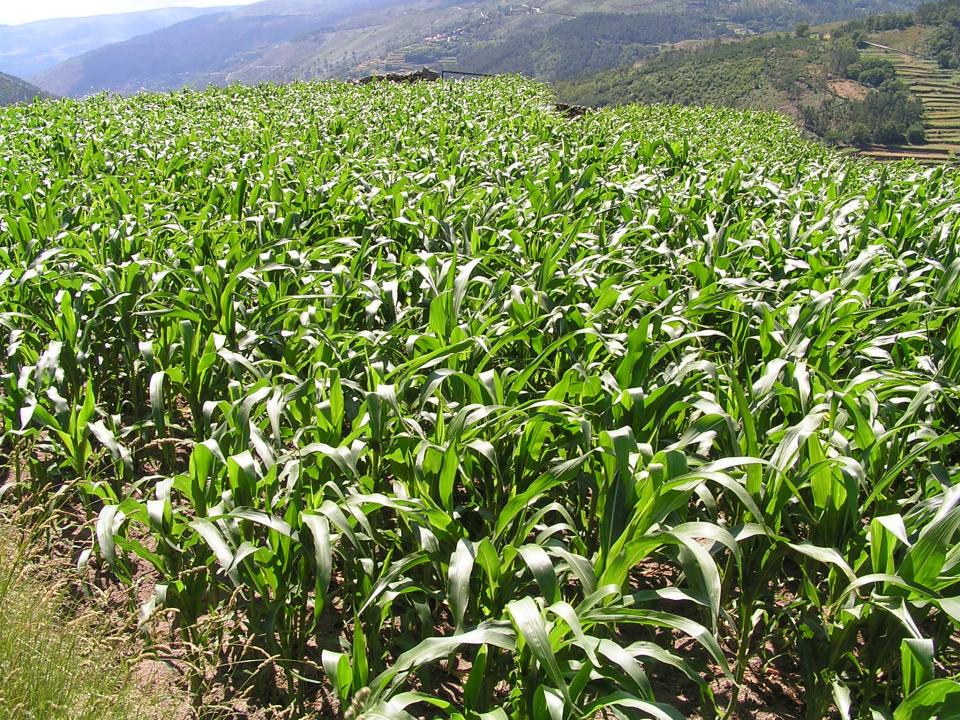In 2006, José Saramago, the 1998 Nobel laureaute in Literature, published Small Memories, evoking his youth. In describing Azinhaga, the Portuguese village where he was born in 1922, Saramago observed that this twenty-first-century landscape “didn’t . . . belong to him,” writing: “this present-day landscape isn’t mine, it isn’t the place where I was born, I didn’t grow up there.” Continuing on, he writes: “In place of the mysterious and vaguely troubling olive groves of my childhood and adolescence, what we see is one enormous, monotonous, unending field of hybrid corn, all grown to the same height, possibly with the same number of leaves per stem, and tomorrow perhaps with the exact same arrangement and number of ears and the same number of kernels on each ear.” What Álvaro Domingues called a “transgenic landscape” (or, more accurately in this case, a hybrid landscape) had emerged in the years he had been away, clouding his sense of belonging and identity.
Corn (Zea mays L.), or maize, has always been a dynamic agent in Portugal. From fifteenth century descriptions of corn’s arrival in Seville, Spain, to eighteenth-century statements emphasizing the role of corn and “it[s] support [of] many people in Beira, Minho, and Galicia by making bread from it,” corn irrevocably altered the history of the northwestern Iberian Peninsula. The overseas travels of Portuguese and Spaniards since the fifteenth century have accelerated the circulation and dissemination of this new-world crop to Europeans. Corn’s genetic flexibility enabled its widespread cultivation in Iberian landscapes. New landraces and folk varieties, perfectly adapted to the new geographies and climates, turned corn into Portugal’s most important cereal. Terraces appeared on the slopes; water became a central element; weeding and intensive agriculture replaced cattle and grazing; corn covered pastures previously sown with linseed and rye. Over the course of these three centuries, in what is often referred to as the “maize revolution,” landscapes and rural practices changed mightily.
Until the early twentieth century, corn was nothing like the depictions of Saramago. At the time, variability attracted the attention of any alert observer. From the 1930s, in Saramago’s childhood, to the 2000s, hybrid species permitted the expansion of corn to the south of Portugal, where they replaced not only Saramago’s olive trees but also the landraces and folk varieties of these traditional corn-growing regions.

Espigueiros, Soajo, Arcos de Valdevez. Complex of 24 granaries for corn storage, classified as Immovable Cultural Heritage since 1983.
Espigueiros, Soajo, Arcos de Valdevez. Complex of 24 granaries for corn storage, classified as Immovable Cultural Heritage since 1983.
© 2022 Inês Gomes. Used by permission.
The copyright holder reserves, or holds for their own use, all the rights provided by copyright law, such as distribution, performance, and creation of derivative works.
In traditional Iberian corn landscapes, as in Minho, in the northwest of Portugal, in fact, the monotonous hybrid also prevailed. From a new, exotic plant in the fifteenth century to a traditional seed in the eighteenth century, by the twentieth century, corn became a technological object. Although the same species, corn evolved into an entirely different plant. Before, it was a vital community member, bringing together villagers for the harvest, making the mills work to make flour, and filling the air with the smell of the wood ovens that baked the bread that fed families. Now corn, the monotonous hybrid, feeds livestock. Its seed has to be renewed every year to maintain its characteristics and thus is no longer chosen from the best grains of the best ears of the most vigorous plants. Its seed is no longer carefully stored like a treasure from one year to the next and must, necessarily, be purchased so that it can take root. In addition, fertilizers and pesticides are to be used, further augmenting production costs.
Corn became a modern crop, a capital crop allowing a number of seed industries to prosper, changing the organization of labor and life experiences. Landraces and folk varieties were pushed out. Agriculture was transformed into an industrial activity. As Deborah Fitzgerald argues, farms were transformed into factories, and, when we look at Saramago’s description of corn fields, we are actually reminded of a Ford assembly line, where economists, engineers, agronomists, government officials, and agricultural industries planned every gesture of the farmer, from the purchase of the seed to its cultivation and harvest.
The industrialization of agriculture goes far beyond the transformation of polycultures into monocultures, the suppression of self-sufficient family farming by large estates, or mechanization. Besides industrial, financial, cultural, and ideological changes, scientists developed modern habitats, growing new seeds and shaping new rural societies. And these new corn seeds, mainly from a limited amount of genetic material obtained from the most productive US Corn Belt varieties, were spread and disseminated globally. The hybrids eroded local agro-biodiversity and increased water consumption, which compromised food security and human well-being and raised the inequalities and asymmetries of contemporary society in addition to degrading overall environmental conditions. Farmers, the wider public, and experts, but also politicians and other agents, engaged in networks of knowledge, agricultural technologies, and seed exchange, turning traditional seeds into commoditized technological objects with instruction manuals. Though they began as agricultural producers, non-corporate farmers have become the consumers of seeds, pesticides, fertilizers, and various new tools, altering their labor structures and relations, weakening social networks, and making survival more precarious.

Terraces in Sistelo, Arcos de Valdevez, Portugal, June 2004. The cultural landscape of Sistelo was classified as a Site of National Interest/National Monument in 2018.
Terraces in Sistelo, Arcos de Valdevez, Portugal, June 2004. The cultural landscape of Sistelo was classified as a Site of National Interest/National Monument in 2018.
© Inês Gomes. Used by permission.
The copyright holder reserves, or holds for their own use, all the rights provided by copyright law, such as distribution, performance, and creation of derivative works.
In this context, romanticized landscapes, sometimes considered national monuments—such as Sistelo, Arcos de Valdevez, Portugal, whose terraces, present since the sixteenth century, are embedded in the history of corn in the Iberian Peninsula—are also “transgenic landscapes.” Today’s Sistelo landscape masks deep social transformations in rural society, a lack of genetic diversity, globalization, the US hegemony in agri-business, and the weight of the Capitalocene. As Saramago contemplates, does this transformed landscape really still belong to us?
Acknowledgments
The main idea for this paper was developed in the framework of the “ReSEED Project: Rescuing Seeds’ Heritage—Engaging in a New Framework of Agriculture and Innovation since the Eighteenth Century.” It has received funding from the European Research Council (ERC) under the European Union’s Horizon 2020 research and innovation program (grant agreement no. 760090), with Dulce Freire as the principal investigator, and is hosted by the University of Coimbra at the Centre of Interdisciplinary Studies (UIDB/00460/2020). This paper reflects only the author’s views. The European Commission and the ERC Executive Agency are not responsible for any use that may be made of the information it contains. Inês Gomes also receives funding from the Institute of Contemporary History (IHC), NOVA University Lisbon. The IHC receives national funding through the Foundation for Science and Technology (FCT), IP, under projects UIDB/04209/2020 and UIDP/04209/2020.
How to cite
Gomes, Inês. “Capital Seeds and Hybrid Landscapes: Between Varied Landraces and Monotonous Technological Objects.” Environment & Society Portal, Arcadia (Summer 2023), no. 12. Rachel Carson Center for Environment and Society. doi:10.5282/rcc/9628.
ISSN 2199-3408
Environment & Society Portal, Arcadia
 This work is licensed under a Creative Commons Attribution 4.0 International License.
This work is licensed under a Creative Commons Attribution 4.0 International License.
2023 Inês Gomes
This refers only to the text and does not include any image rights.
Please click on an image to view its individual rights status.
- Domingues, Álvaro. Paisagens Transgénicas. Lisbon: Museu da Paisagem, 2021.
- Fitzgerald, Deborah Kay. The Business of Breeding: Hybrid Corn in Illinois, 1890–1940. Ithaca, NY: Cornell University Press, 1990.
- Fitzgerald, Deborah Kay. Every Farm a Factory: The Industrial Ideal in American Agriculture. New Haven, CT: Yale University Press, 2003.
- Moore, Jason W. “The Capitalocene, Part I: On the Nature and Origins of Our Ecological Crisis.” Journal of Peasant Studies 44, no. 3 (2017): 594–630. doi:10.1080/03066150.2016.1235036.
- Pereira, Elvira, Cibele Queiroz, Henrique Miguel Pereira, and Luis M. Vicente. “Ecosystem Services and Human Well-Being: A Participatory Study in a Mountain Community in Portugal.” Ecology and Society 10, no. 2 (2005): 14. doi:10.5751/ES-01353-100214.
- Ribeiro, Orlando. Portugal, o Mediterrâneo e o Atlântico: Esboço de relações geográficas [Portugal, the Mediterranean, and the Atlantic: Outline of geographical relations]. Lisbon: Sá da Costa, 1986.
- Saramago, José. Small Memories. Translated by Margaret Jull Costa. Boston: Houghton Mifflin Harcourt, 2011.









